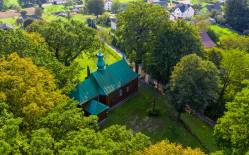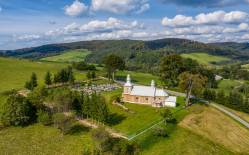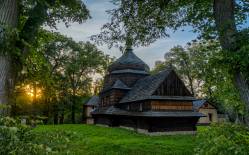In Jurowce you can see a wooden Greek-Catholic tserkva of St. George, built in 1873. After 1947 it was acquired for the needs of Roman Catholics.
Oriented towards the east, the three-part building is a post and beam structure (which is rare in our tserkvas). The sacristy is on the southern, and the founder’s chapel is on the northern side of the chancel. The nave features transept chapels with semi-hexagonal walls. Each part of the structure is covered with a dome raised on an octagonal tholobate with a false roof lantern. The roof is covered with sheet metal, and the outer walls are clad with vertical wood boards.
Inside there are flat octagonal dome ceilings, while the sacristy and the founder’s chapel feature false ceilings. The entrances from the nave to the chapels have decorative framings. In the chancel there are portals leading to the sacristy and the chapel; these feature small columns on the sides and decorative cornice at the top. The wall paintings are as old as the building itself. In the dome you can see the celestial sphere and a Catholic image of God the Father. There are no relics of the iconostasis. The side altar with icons of Christ Pantocrator and Christ on the Cross dates from the 1800s.
Next to the tserkva we can see a Classicist zvonnitsa-type bell tower from 1905. The brick structure comprises two stories and three domes. The smallest bell carries the date 1670. Adjoining the tower, the sculpted statue of St. Andrew is contemporary to the belfry. On the other side of the road there is a lovely, neo-Classicist manor house from the 19th century, owned by the Słonecki family. The complex comprises an old landscaped park with a pond.
Towering over the village there is a wide spreading hill called Wrocień. According to a legend, its name is associated with a hermit, a physician and a healer once living on its slope.
Photos: Krzysztof Zajączkowski, Michał Bosek
Gallery
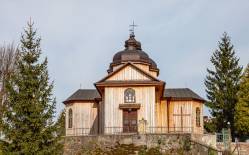
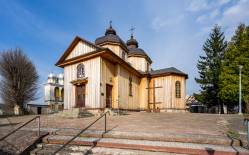
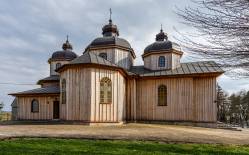
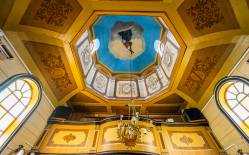
Recommended venues on the Trail



This website has been modernized with the financial support of the European Union under the Cross-Border Cooperation Programme Poland-Belarus-Ukraine 2014-2020. The responsibility for its content lies solely with the Podkarpackie Regional Tourism Board and cannot, in any case, be treated as a reflection of the position of the European Union, the Managing Authority, or the Joint Technical Secretariat of the Cross-Border Cooperation Programme Poland-Belarus-Ukraine 2014-2020.










